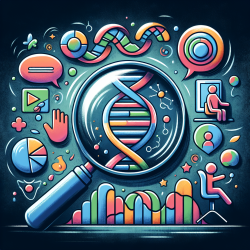Understanding the Role of Elp2 Mutations in Neurodevelopmental Disorders
The recent study titled "Elp2 mutations perturb the epitranscriptome and lead to a complex neurodevelopmental phenotype" offers groundbreaking insights into the genetic underpinnings of intellectual disability (ID) and autism spectrum disorder (ASD). As a practitioner in speech language pathology, understanding these findings can significantly enhance your ability to support children with these conditions.
The Genetic Landscape: Elp2 Mutations
Elp2, a subunit of the Elongator complex, plays a critical role in brain development. The study identifies that mutations in the Elp2 gene can disrupt the epitranscriptome, leading to a cascade of developmental anomalies. These mutations affect protein stability and the activity of the Elongator complex, crucial for tRNA modification, which in turn impacts neurogenesis and brain connectivity.
Clinical Implications for Practitioners
For practitioners, these findings underscore the importance of genetic factors in neurodevelopmental disorders. By understanding the molecular mechanisms at play, practitioners can tailor their therapeutic approaches to address the specific needs of children with Elp2-related anomalies. Here are some key takeaways:
- Early Identification: Genetic testing for Elp2 mutations can aid in early diagnosis, allowing for timely intervention.
- Targeted Therapy: Understanding the specific disruptions caused by Elp2 mutations can guide the development of personalized therapy plans.
- Collaboration with Geneticists: Working closely with geneticists can provide a comprehensive approach to managing these complex conditions.
Encouraging Further Research
While this study provides valuable insights, it also opens the door for further research. Practitioners are encouraged to stay informed about ongoing studies and consider participating in research initiatives. Collaborative efforts can lead to more effective interventions and improved outcomes for children affected by these mutations.
Conclusion
The research on Elp2 mutations highlights the intricate relationship between genetics and neurodevelopment. By integrating these insights into practice, speech language pathologists can play a pivotal role in supporting children with ID and ASD. Embracing a data-driven approach will not only enhance therapeutic outcomes but also contribute to the broader understanding of neurodevelopmental disorders.
To read the original research paper, please follow this link: Elp2 mutations perturb the epitranscriptome and lead to a complex neurodevelopmental phenotype.










